| 'Like' us on Facebook | Follow us: |
Posted on: Apr 23, 2019
THE SAI PANCHARATNA KRITIS
Part - 5
Part 1 | Part 2 | Part 3 | Part 4
The Sai Pancharatna Kritis are special Carnatic compositions describing the life story and the glory of the Sathya Sai Avatar. They were first presented at the Lotus Feet in the year of Swami's 90th Birthday on Aradhana Day 2015.
The Sai Pancharatna Kritis being offered at the Sannidhi on April 24, 2015
| Sai Pancharatnas – Lyrics and Meaning | Sai Pancharatnas – Tutorial |
Subsequent to this presentation, in answer to many devotees' queries, we had many live Radio Sai discussions about the making and the meaning of these compositions in our programs “Outside Inside Deep Inside” as well as “Morning Glory”.
Presented below are edited excerpts of the third 'Outside Inside Deep Inside' discussion which had as its participants, Radio Sai team members, C. G. Sai Prakash (CG), Anirudh Srinivasan (AS), and Bishu Prusty (BP), as well as Ms S. V. Vasumathi (SVV), the Vice Principal of Sri Vishwa Vidyalaya Matriculation High School, Chennai.
In this episode they dwell on the musical beauty as well as profound depth of the lyrics of the first Sai Pancharatna Kriti – “Pranamami Saiesha”.
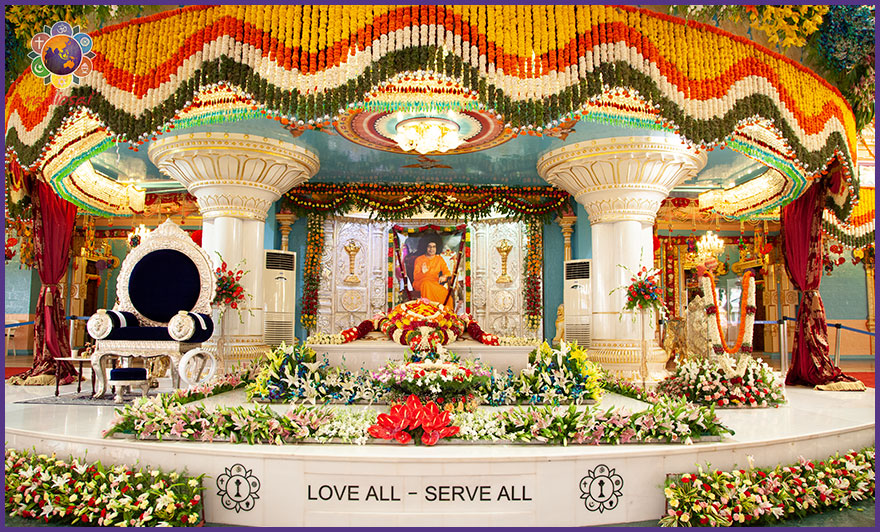 |
The Structure of Pancharatna Kritis vis-a-vis Tyagaraja Kritis
CG: Raj Kumar Bharathi Sir has chosen Gambheera Nattai for the first kriti and there's no doubt that this is a very grand raga for the opening.
AS: Yes. It's a grand opening song. The lyrics definitely make the most impact with their meaning, as they are very rich. But what adds so much of colour to the lyrics is the raga which has been selected.
When I heard the first line ‘Pranamami Sayeesha’, I felt the way it is tuned is so divine! You can just close your eyes and listen to the song.
Pallavi:
praṇamāmi sāyīśa sakala bhuvana śubhakara ghanacarita
sṛṣṭi sthiti kāraka suguṇākara ratnākara vamśābdhi sudhākara
Anupallavi:
praṇatārtihara śivaśakti rūpa bhāradvāja gōtrōdbhava
nī padamu sōki bhuvi dhanyamāye nī karuṇakilanu evaru sāṭi
CG: When you sing ‘sakala bhuvana shubhakara’, the way the word ‘bhuvana’ is tuned gives a feeling of roundness! It makes you really feel, “Yes, yes! He is talking of the whole world!”
SVV: Correct!
CG: That's what I meant when I said that Sir has taken word by word and tuned! One unique feature of the Sai Pancharatnas is that there is no scope for unclear pronunciation of the words. The tune has been made in such a way that you are forced to pronounce the words clearly.
SVV: There is a practice where some singers do not close their mouth at all. Instead of singing ‘mm’ they tend to sing ‘unnn’. Sir was very particular that we close our mouths and render the aksharams (syllables) very perfectly. Some of us were from Tamil Nadu and other states and so he said that the pronunciation has to be correct with respect to where the stress has to be given. All through our rehearsals he kept telling us, “Close your mouth here. Give the stress here.” It is rare to see someone giving attention to this much detail!
CG: This first kriti is dedicated to Swami's birth and lineage, His early life and how He did His early leelas and mahimas, and attracted the devotees. There were simple devotees and the sophisticated from the cities as well as intellectuals and holy men.
In fact, the second charanam of this kriti says, ‘Sadhu mauni jana prarthana phalitham’ which means "Owing to the prayers of the sadhus, You came down to earth." So Swami's incarnation caters to all people from all walks of life.
I have a question for Anirudh. Have you learnt Carnatic music for a few years?
AS: Yes.
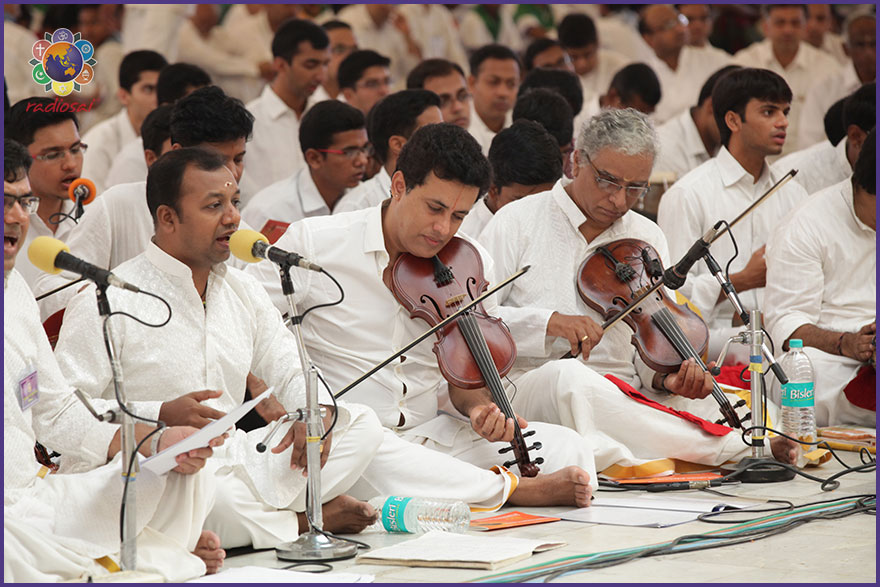 |
CG: I think there is a distinctive feature in Tyagaraja's Pancharatna Kritis in the way they are composed and their structure. The structure of the Sai Pancharatna kritis and the way they are composed are also in line with those kritis. But what I wanted to ask is this: is the structure of Tyagaraja's Pancharatna Kritis different from regular kritis?
AS: Tyagaraja's Pancharatna kritis are unique five gems of Carnatic music. Many kritis have a pallavi or two lines in the beginning and then the anupallavi and the charanam. There are many kritis and even varnams where one more element called chittaswaram is there. These are a short sequence of swaras after the pallavi. They can be sung in the first speed and sometimes we sing them even later in the second speed like how we have in varnams.
CG: Okay. The Carnatic system of music is a scientific approach to teaching and learning music. Apart from the fact that all the songs are devotional in nature and dedicated to some God or Goddess, there is a structure. First you learn the swaras and then move on to janta swaras. Next you go on to varnams and then to kritis and finally to Tyagaraja's Pancharatna Kritis.
AS: Of course, it's a never-ending ocean and you can go on learning. But once you master the Pancharatna Kritis you have a different feel altogether because you learn them after learning so many kritis.
CG: In the Sai world, it looks like we have started from the Sai Pancharatna Kritis!
AS: It is a huge start!
CG: The only thing that comes to my mind is what Swami says: "Mookam karoti vachalam”. He can make even the dumb person speak! Similarly here, Swami is able to bring forth the Sai Pancharatna Kritis from people who have not really got deep into Carnatic music!
AS: I remember Swami's rendition of many of Tyagaraja's kritis such as ‘Brocheva’ and ‘Rama Nannu Brovara’.
CG: Swami has sung even Tyagaraja's Pancharatna Kritis.
AS: Yes. He would even frequently ask singers to sing ‘Endaro Mahanubhavulu’. I remember my brother Aswath singing it on many occasions in front of Him. Swami always gives importance to Tyagaraja's Pancharatna Kritis. The Sai Pancharatna Kritis also have a similar pattern where swarams come first.
CG: We already discussed the pallavi and anupallavi of this kriti and how the phrase ‘sakala bhuvana’ is tuned to make you really feel as if every tree, twig and animal on earth is included! We also discussed how the way ‘srishti sthithi karaka sugunakara’ is tuned ensures that one gets the pronunciation absolutely clear. Raj Kumar Bharathi Sir is a stickler for getting the pronunciation right.
BP: We have seven charanams in the first kriti.
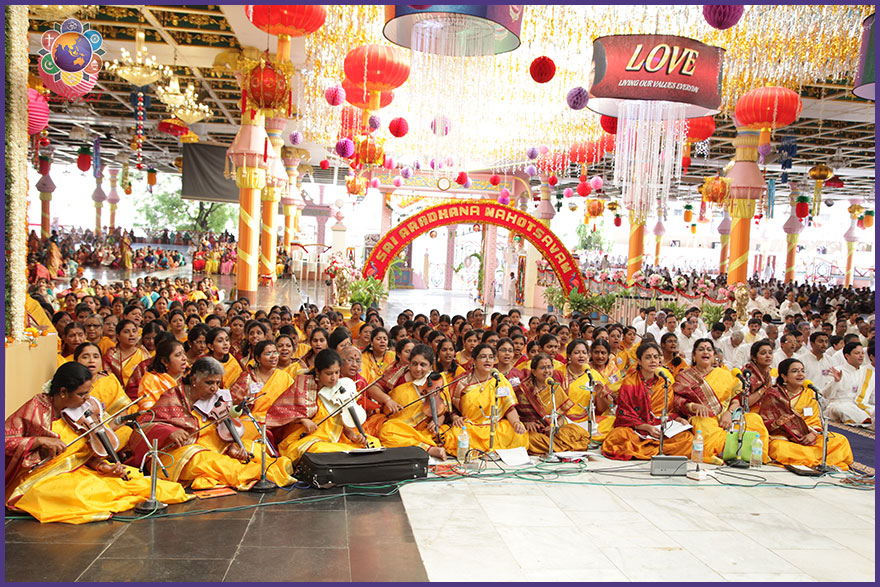 |
The Lovely Divine Glories Packed in the First Four Charanams
CG: Let us listen to the first charanam and take it from there.
nī divyāvatāramu kalilō prēma itihāsamu
tavacaraṇam mama śaraṇam bhakti mukti pradāyakam
Meaning:
Your divine incarnation is a saga of Love in this kali age;
Your feet is my refuge, it confers upon me devotion and liberation.
 |
This kriti glorifies Bhagawan's Avatar, the purpose of His Advent, how He chose the lineage He wanted to incarnate in and then it goes on to some of the early leelas that He performed. But before all that, in the very first charanam, we say, “Swami, Your descent on earth has really purified the earth”.
If you go to the third charanam, it beautifully says ‘Soorya chandragni trinetra shobhita roopa jita bhakta hridaya, pamara jana tapatraya kshayakara sootratraya bodhaka’. What the lyricist has brought out here is based on some of the incidents narrated by devotees from the past.
In the early days of the Patha Mandir, Swami would suddenly call for a trip to the banks of the Chitravathi. We have heard Mrs. Vijayamma (author of the book ‘Anyatha Sharanam Nasti’) describing those days. She was a young girl then.
The picture that comes to my mind is of a person selling candy on the road ringing the bell shouting, “Candy! Candy!” and everybody running towards him. Similarly Swami would suddenly say, “Come! We will go now” and all the children and elders would go with Him.
I asked Mrs Vijayamma a very interesting question. The Patha Mandir is now the Pedda Venkamaraju Kalyana Mandapam and the Chitravathi Road is way ahead at a long distance. If Swami really wanted to go to the Chitravathi, He could have just come out from the Patha Mandir and gone straight to the river.
I asked her, “Why is this road called ‘Chitravathi Road’ when the Patha Mandir is there? Swami could have just gone from there.”
But she said, “No no. Inevitably He would always come to this road. Even in those days of the Patha Mandir, although the whole area was filled with fields, forests and hillocks with no buildings at all, Swami would walk from there and come all the way here because this was close to the Kalpavriksham. So that is the road in which you have the Kalpavriksham tree and it is now called ‘Chitravathi Road’.” The Kalpavriksham is mentioned in the next charanam.
 |
In this charanam, ‘soorya’ refers to the sun, ‘chandra’ is the moon, ‘agni’ is the form of fire and ‘trinetra’ is ‘third eye’. The phrase ‘shobita roopa jita bhakta hridaya’ means “You won over the hearts of the devotees by showing this glorious vision.”
In fact, Mrs Vijayamma describes it so beautifully. She says, “We were all sitting with Swami and having some tiffin and small talk. Suddenly He said, ‘Look where I am!’ and He was not there on the carpet.”
They looked up and He was standing right on top of the hill in an instant. Just wish we could have recorded on video those beautiful leelas! From the top of the hill Swami said, “Now see My form.” Then they saw Him as the sun and the moon, and they also saw His third eye. Glorious visions!
Swami showed them the vision of dashavataras (ten incarnations). So every charanam in this song is based on incidents that have been narrated by devotees from those times.
Mrs Vijayamma mentions that many devotees fainted after having certain darshans because they could not take the power. Then Swami came back in their midst and materialised vibhuti and put it on their foreheads with His thumb, in His characteristic style. She says, “That's what brought us back.”
The second line is ‘Pamara jana tapatraya kshayakara sootratraya bodhaka’ which means, "You dispel the worry of the simple folk by teaching them Your three-fold message." After all, those devotees were people from the village - very simple, devout and pious. ‘Sootratraya bodhaka’ refers to teaching the three important aspects of spiritual sadhana: daiva preeti (love for God), papa bheeti (fear of sin) and sanga neeti (morality in society).
BP: Oh! The three sutras are not elaborated but she has put in that idea!
CG: Yes. The lyricist says, “You taught them the three aspects of daiva preeti, papa bheeti and sangha neeti.”
The fourth charanam says “You showed Yourself in the moon and the sun and also the dashavatara vaibhavam.” I almost feel as if Swami is sitting with the devotees on the banks of Chitravathi and in a corner there is a journalist writing down what she is feeling! That is because all these are more or less events that happened on the banks of the river Chitravathi.
The Deep Significance of the Last Three Charanams
The fifth charanam has the words ‘Sangeetha sarvagna naigama paramya bhashyartha vachonipuna, nee leela mahimalu vinodamulu chitra vichitramulu, divyamu bhavyamu navyamu rasaramyamu nee padame parama padamu’.
Swami would sit on the banks of the river Chitravathi and ask people to sing. He also would Himself sing. He was and is the knower of all music!
If Swami wanted He could have got the best of singers to sing bhajans in the mandir but He encouraged His students to sing. If we sing three lines in shruti, we think we are great singers but He just tolerated and lived with our music! It is just His love that prompted Him to encourage His children to sing and that's what He did even during the old days.
‘Sangeetha sarvagna naigama’ means "You are the expert because You know all music." The phrase ‘bhashyartha vachonipuna’ means “You know how to give scholarly expositions on the shastras or scriptures”. He did that on the banks of the river Chitravathi.
Then comes the phrase ‘Nee leela mahimalu vinodamulu chitra vichitramulu’ which means "Your leelas are indeed very mysterious and beautiful." The adjective ‘divyamu’ means ‘divine’, ‘bhavyamu’ means ‘exhilarating’, ‘navyamu’ means ‘unique and new’ and ‘rasaramyamu’ means ‘nectarous.
The Telugu language mixed with Sanskrit is so beautiful. The first kriti has a lot of Sanskrit phrases. The phrase ‘Nee padame parama padamu’ means “Your feet are the ultimate goal for everybody”. This is how this charanam goes. Now let us listen to the sixth charanam to get its essence.
kōrina phalamulanella nosage cinta drumam
celimikānḍra muccaṭa dīrcē kalpabhūjam
talacinantanē sṛṣṭi jarugu satya sankalpam
prēmarūpa sāyi karatalamē kalpakam
Meaning:
The tamarind tree was transformed into the wish fulfilling tree, it gave everything Your childhood friends desired;
You possess the Sathya Sankalpa (Resolve of Truth) that make things happen the moment You will it. O embodiment of love, Sai, Your palm itself is verily the wish-fulfilling tree.
 |
CG: This charanam mostly describes the leela of Bhagawan related to the Kalpavriksha tree. It says, "The tamarind tree was transformed into the wish-fulfilling tree. It gave everything Your childhood friends desired. You possess the sathya sankalpa or the resolve of truth that makes things happen the moment You will it. Oh embodiment of love, Sai, Your palm itself is verily the wish-fulfilling tree.”
I'd just like to bring to notice that the wish-fulfilling tree concept itself is new! If we talk of the leelas that the previous avatars showed, yes, Lord Krishna showed many leelas but this concept is novel! "Come to a tamarind tree and ask for what you want, and the tree will give you!" That is the beautiful leela of Bhagawan!
At the end of this charanam the lyricist says, “After all, the palm of Your hand is the kalpavriksha.” How true! In some interviews Swami would play a game showing His hand and ask, “What is in this hand?” We would look at each other, wonder and say, “There is nothing in Your hand, Swami” but He would reply, “No! There is everything in this hand!”
There were countless materialisations from the sweet and small palm of Swami. One outstanding feature I'm sure all of us have observed is that when Swami materialises something, the person who is most excited is Him!
When He brings out vibhuti or a ring or chain, we can see the glow in His eyes which is so beautiful because He is going to thrill you and make you happy. He is the one who is most happy! The idea that everything is from His Divine Hand is brought out very beautifully in the phrase ‘Prema roopa Sai karatalame kalpakam.’
SVV: The tuning is also apt for this phrase.
CG: Exactly! The whole charanam is beautiful because this is a very mysterious leela. The way the swaras are jumping going back and forth reflects that. It's just divinely inspired and it is ‘chitra vichitramulu’, as the previous charanam says!
Now we go to the last charanam in this kriti where Mrs Vasanthalakshmi, the lyricist, has brought out a few interesting concepts, again divinely inspired by Bhagawan. She says, ‘Adi antyamuleni adbhuta leela vinodam’ which means "There is no beginning or end to Your leelas." She then says, "Your leelas and stories are endless, like the gently dancing wave." She has used the simile of waves which are born, grow and fall in the sea.
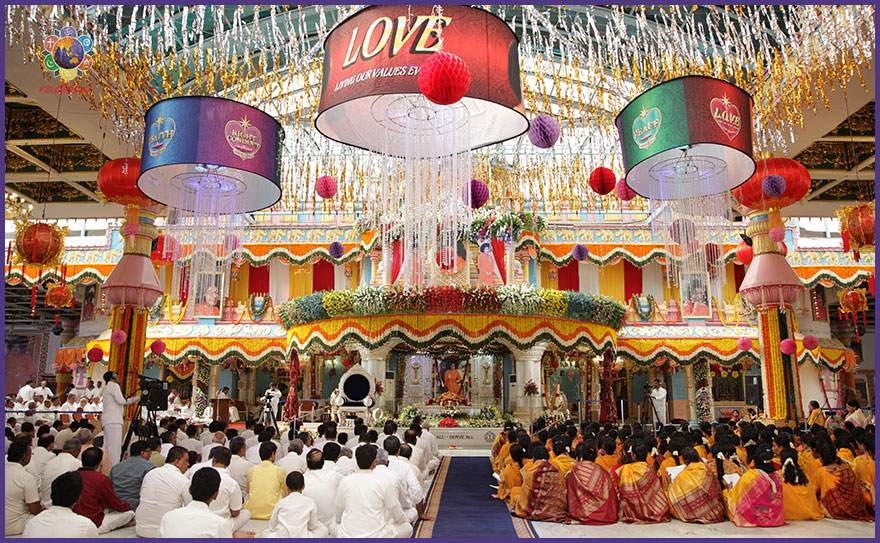 |
Then she says, "At one moment in time, for the devotees You are divine and You are aloof. You show them awe-inspiring visions and You are the great God. But the next instant You are right with them, Your love overwhelms them and You are one amongst them."
If you speak to any of the devotees who were there in the old days, they will say, “Swami was so much one amongst us.” But today if they sit and try to analyse with a logical mind, they wonder how they felt one with a person who just showed them the visions of the dashavatars!
In one instant He showed all the ten forms of God but in the next instant He was with them. That was the maya! That was His love which just overpowered everything! The devotees felt, “After all He is our Swami!”
The way the lyricist has brought it out here is so apt and real because when Mrs Vijayakumari was narrating the incident of Trinetra Darshan, she said that they saw a huge face of Swami filling the entire sky and huge sparks of fire coming out from His third eye. Many of them fainted.
They could not bear the power of the vision but in their subconscious mind, the first thought that came was, “Oh! I hope these flames don't harm Swami.” They are so used to thinking, “Our Swami, my Swami, the Swami who is with me, standing next to me asking me whether I had breakfast and lunch.”
BP: “We don't want all these visions, Swami! You just be with us.”
CG: The devotees thought, "I hope those flames don't harm Swami." That's the beauty of maya. Do you think that the God who is able to give you that vision can't protect Himself?
BP: It only shows how even though the infinite One is so grand, He was still able to have such an intimate relationship with each one of us and bring Himself down to such a level that we feel one with Him.
CG: That's the beauty and that is what is celebrated in these two lines. She says, "Yes, You are the all-powerful Lord but then with Your love You attract everybody and make everybody forget Your divine nature."
BP: I was speaking to brother K Arun Kumar who did his Masters and Ph.D. here. For him, everything was new when he joined the university. He said, “In Kodaikanal when we spend so much time with Swami from dawn to dusk, we forget that He is the Lord. The only time we realised this palpably was when He went out for darshan. That was when we saw how so many people were waiting for a glimpse of Him.”
There are occasions when someone would just see Swami's hair and say, “Oh! I have seen Swami's hair.” And for that itself they would go into ecstasy!
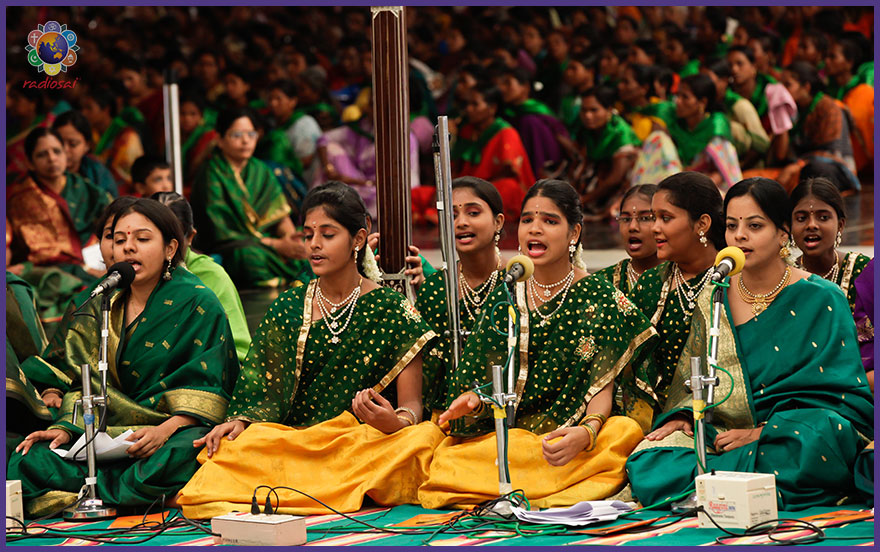 |
Brother Arun said that even though Swami was spending all the time with the students, He was constantly looking at the clock. For Him, going for darshan was such a big thing. He kept saying, “I have to go for darshan.” But on the journey to Kodaikanal, He would get into the bus and mingle with the students. We have seen pictures of Him wearing sun glasses. We really forgot that He was anything extraordinary!
CG: His love was most overpowering! But the last line gives the next twist in this kriti. It says, "To have recognised Your divinity even when You were young is indeed a great good fortune of the devotees of yore." Yes, children would get mesmerised and awestruck, and feel kinship with Bhagawan but there were a few great devotees who in spite of having proximity and accessibility to Him always knew in the core of their hearts and in the back of their minds whom they were playing and living with!
BP: ‘Alanati bhakthula bhagyame bhagyam.’
CG: Yes, that is the good fortune of those devotees. We can end the discussion on this kriti with the rendition of the seventh and last charanam.
AS: Even the beginning of the charanam is very beautiful. It goes from the low ‘sa’ note to the high ‘sa’ note and the lyrics are ‘Adi antyamuleni’ where ‘adi’ means ‘beginning’ and ‘antya’ means ‘end’.
ādi antyamulēni adbhuta līlā vinōdam
sāyi prēma kaḍali keraṭāla lāsyam
bhaktāḷiki oka kṣaṇamuna divyānubhūtula pāravaśyam
marukṣaṇamuna satya premākarṣaṇa mānava sahāja
naijam pasitanambunanē paramātmagā nerigina
alanāṭi bhaktula bhāgyamē bhāgyam
Meaning:
Sai's delightful and fascinating play is without a beginning or an end; Sai’s love is like the gently dancing waves.
For the devotees, at one moment it is an overwhelming Divine experience (with You) but the very next instant, it is a powerful attraction to Your (human side) true love.
To have recognised Your divinity even when You were young, is indeed a grand fortune of the devotees of yore.
 |
AS: Singing the swaras part is very challenging!
CG: I noticed that it is quite a long charanam. We could bring to the notice of the devotees that the structure of the kriti is such that the length of the charanam keeps increasing as we go on from one charanam to the next.
SVV: So also the complexity!
AS: It gives the feel of a grand finale! We were practising the phrase ‘Alanati bhaktula bhagyame bhagyam’ again and again to get it right. Also the swaras ‘ni sa ni sa’ suddenly go from the higher octave to the lower octave. It is tough and we need to practise thoroughly to sing it correctly.
CG: If we take the word ‘vinodam’ it lands on the note ‘ma’. This is another concept we need to mention. Those well-versed in Carnatic music will know the concept of swaraksharam. It is more profound in the second kriti.
There are few swaraksharams even in the first kriti but the second kriti really abounds in them. A swaraksharam refers to words formed with swaras incorporated into the word structure. The word ‘sada’ in the first line of the second kriti ‘Sada Bhavayami’ means ‘always’ but the syllables ‘sa’ and ‘da’ of this word also have the musical notes as ‘sa’ and ‘da’ respectively. This is called ‘swaraksharam’.
AS: Yes. That will be the moving point for the second kriti. New feature added on!
CG: Yes. We are grateful to Bhagawan for having given us the Sai Pancharatnas and now given us the chance to soak in that bliss. Subsequent generations too can soak in the bliss. The idea is that people all over the world with a bent of mind towards music can learn these kritis and offer to Bhagawan in their homes, samithis or Sai centres and temples, and on April 24, you will have one voice all over the world offering these kritis to Bhagawan!
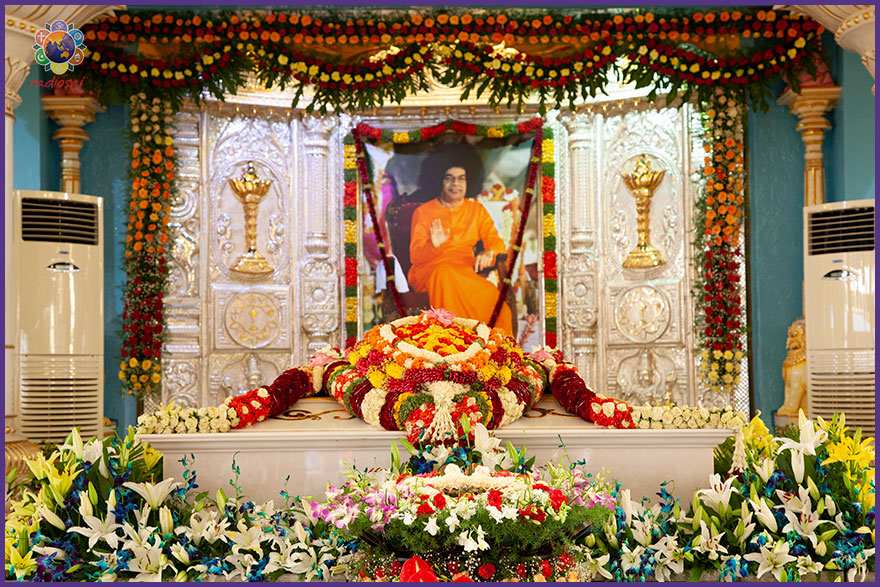 |
BP: Wow! Just imagine how it will be when one day the entire Sai Kulwant Hall or at least 60 per cent of it is filled with Carnatic musicians and everybody is singing these kritis!
CG: It should happen!
BP: What a glorious occasion that would be!
SVV: Everybody sitting in Sai Kulwant Hall will sing these kritis. They will become the Carnatic musicians!
CG: After hearing these kritis 100 times, at least we will be able to sing something! They are not easy like bhajans. But we should make the attempt.
BP: That will be such a useful and fulfilling exercise for anyone who has learnt Carnatic music or plans to learn or loves Carnatic music.
CG: That's the point! You start with Swami's kritis.
BP: Mrs. Padma Kasturi, the daughter of late Prof. Kasturi, was so thrilled when she heard the story of how the Sai Pancharatnas happened. She called me immediately after the first episode in this series of discussions on these kritis and she was almost in tears of joy. I'm sure there will be so many like her.
CG: This is just one project of Bhagawan and if you take everything in your life as a project for Him, you will see His hand all the time. That's the beauty!
Part 1 | Part 2 | Part 3 | Part 4
- Radio Sai Team
| comments powered by Disqus |






